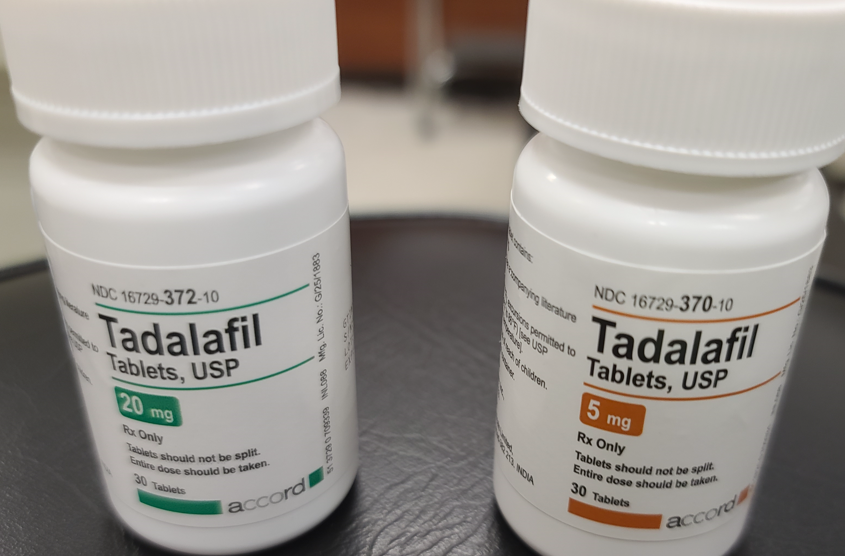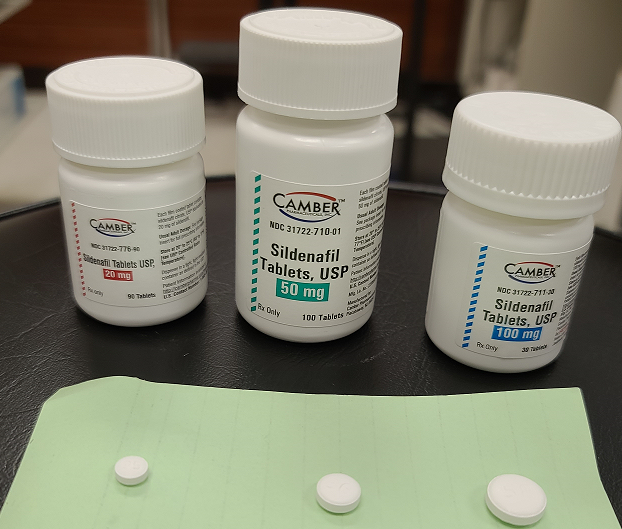Tadalafil (Cialis) is used to treat erectile dysfunction (ED, impotence; inability to get or keep an erection), and the symptoms of benign prostatic hyperplasia (BPH; an enlarged prostate) which include difficulty urinating (hesitation, dribbling, weak stream, and incomplete bladder emptying), painful urination, and urinary frequency and urgency in adult men. Tadalafil (Adcirca) is used to improve the ability to exercise in people with pulmonary arterial hypertension (PAH; high blood pressure in the vessels carrying blood to the lungs, causing shortness of breath, dizziness, and tiredness). Tadalafil is in a class of medications called phosphodiesterase (PDE) inhibitors. It works to treat erectile dysfunction by increasing blood flow to the penis during sexual stimulation. This increased blood flow can cause an erection. Tadalafil treats PAH by relaxing the blood vessels in the lungs to allow blood to flow more easily.
If you are taking tadalafil to treat erectile dysfunction, you should know that it does not cure erectile dysfunction or increase sexual desire. Tadalafil does not prevent pregnancy or the spread of sexually transmitted diseases such as human immunodeficiency virus (HIV).
Typical dosing for Cialis (tadalafil)
- Cialis (tadalafil) is typically taken as a 10 mg dose about 30 minutes before sexual activity when needed. The dose can be adjusted anywhere from 5 mg to 20 mg depending on response Cialis (tadalafil) should not be taken more than once a day at any dose.
- For people taking Cialis (tadalafil) daily, the usual dose is 2.5 mg to 5 mg by mouth once a day. This does not have to be timed based on sexual activity.
What’s the difference between Cialis and Viagra?
Cialis and Viagra are both PDE5 inhibitors used for the treatment of erectile dysfunction (ED).
- Both only work when a man is sexually aroused.
- Cialis lasts for around 36 hours compared with only 4 to 5 hours for Viagra.
- Food does not affect the activity of Cialis, whereas food may decrease the effectiveness of Viagra.
- Cialis can be used once daily, at a smaller dosage, and is also effective at treating benign prostatic hyperplasia (BPH).
- Dosage of Cialis may need to be reduced in men with liver or kidney problems and risk of interactions may be higher than with Viagra.
What ingredients are contained in Cialis or Viagra and how do they work?
Cialis is the brand name for tadalafil and Viagra is the brand name for sildenafil.1,2 Both belong to a class of medicines known as phosphodiesterase type 5 (PDE5) inhibitors. PDE5 inhibitors work only in the presence of sexual stimulation, as they rely on the natural release of nitric oxide (NO), a chemical only released during sexual arousal. NO in turn activates other substances to relax the smooth muscle inside the penis to allow the inflow of blood and an erection to occur.
PDE5 inhibitors enhance the effect of NO.
Which drug was approved first?
On March 27 th, 1998, Viagra became the first oral pill, and the first PDE5 inhibitor, to be approved by the FDA to treat ED. A generic for Viagra was approved in March 2016 and released in December 2017.
Cialis was first approved for ED on November 21st, 2003. It was the third PDE5 inhibitor to come onto the market (after Levitra [vardenafil]).
Which one lasts for longer?
Cialis has an advantage over Viagra and Levitra in that it lasts for a lot longer – 36 hours, compared with 4-5 hours for Viagra and Levitra. A generic for Cialis was approved in May 2018 and released in September 2018.
How quickly do Cialis and Viagra work and does food have any effect?
Cialis generally works within 16 to 45 minutes, and its activity is not affected by food.
Viagra generally works within 30 minutes, and its effect may be diminished if taken soon after a high fat meal (which may also delay how fast it works). For this reason, Viagra is best taken on an empty stomach.1,2,7
Effectiveness of all PDE5 inhibitors is similar; although reported effectiveness of Viagra, at 84% is slightly higher than that of Cialis at 81%. However, more men prefer Cialis because of its longer duration of effect.
What is the usual dosage of Cialis or Viagra?
Cialis can be taken on an as needed basis, or daily. Generally, daily dosages are smaller than as needed doses. Typically, Cialis is taken as a 10mg starting dose, prior to sexual activity. The effects of Cialis will last around 36 hours. The dosage may be increased to 20mg if 10mg is ineffective or reduced to 5mg if side effects are intolerable.1
When Cialis is taken for daily use, the recommended initial dosage is 2.5mg once daily, or 5mg for people who also have BPH. Timing of the daily dosage does not matter in people using it solely for ED; however, those with BPH are advised to take it at the same time each day. Do not take more than one dose a day but your doctor may consider an increase in dosage from 2.5 to 5mg if ineffective. Side effects of Cialis include headache and indigestion.1
Viagra is taken on an as needed basis, at a dose of 50mg, approximately 1 hour before sexual activity (although can be taken from 30 minutes to 4 hours before). The dose may be increased to 100mg if 50mg is ineffective or decreased to 25mg if side effects are intolerable.2 Viagra should only be taken once a day even though the effects wear off after approximately 4-5 hours. The main side effects are headache, flushing and indigestion.2 Rarely, color perception may be altered with Viagra. This side effect does not happen with Cialis.7
Cost of Viagra varies depending on tablet strength but is approximately $80 per tablet for the 50mg or 100mg strength. Cialis costs approximately $12 for the 5mg strength and $70 for the 20mg strength, per tablet.
All PDE5 inhibitors are contraindicated with nitrates.1,2 The longer duration of action of Cialis means it is at higher risk for drug interactions,1 and dosages may need reducing in men with kidney or liver disease. Cialis is not recommended in men who have had a heart attack or stroke within the past 6 months, with either uncontrolled high blood pressure or severely low blood pressure, unstable angina, or other conditions that make sexual activity inadvisable.

